A Combination of Taurine and Caffeine in Stallion Semen Extender Positively Affects the Spermatozoa Parameters
Abstract
1. Introduction
2. Materials and Methods
2.1. Semen Collection and Processing
2.2. Motility Analysis
2.3. Viability
2.4. Ferric Reducing Ability of Plasma (FRAP)
2.5. Total Oxidant Status (TOS)
2.6. Statistical Analysis
3. Results
3.1. The Effect of Taurine and Caffeine on the Spermatozoa Quality
3.2. The Effect of Taurine and Caffeine on the Extracellular Oxidative Stress
3.3. Correlation Analyses
4. Discussion
5. Conclusions
Author Contributions
Funding
Institutional Review Board Statement
Informed Consent Statement
Data Availability Statement
Conflicts of Interest
References
- Halo, M.; Tirpák, F.; Kováčik, A.; Lípová, P.; Greń, A.; Massányi, P. Biochemical parameters of seminal plasma affect motility traits of stallion spermatozoa. J. Microbiol. Biotechnol. Food Sci. 2018, 7, 516–518. [Google Scholar] [CrossRef]
- Katila, T. Procedures for handling fresh stallion semen. Theriogenology 1997, 48, 1217–1227. [Google Scholar] [CrossRef] [PubMed]
- Batellier, F.; Vidament, M.; Fauquant, J.; Duchamp, G.; Arnaud, G.; Yvon, J.M.; Magistrini, M. Advances in cooled semen technology. Anim. Reprod. Sci. 2001, 68, 181–190. [Google Scholar] [CrossRef] [PubMed]
- Aurich, C. Recent advances in cooled-semen technology. Anim. Reprod. Sci. 2008, 107, 268–275. [Google Scholar] [CrossRef] [PubMed]
- Partyka, A.; Niżański, W. Supplementation of avian semen extenders with antioxidants to improve semen quality—Is it an effective strategy? Antioxidants 2021, 10, 1927. [Google Scholar] [CrossRef]
- Halo, M.; Massányi, M.; Tokárová, K.; Tirpák, F.; Greifová, H.; Solár, D.; Halo, M.; Massányi, P. High taurine concentrations negatively effect stllion spermatozoa parameters in vitro. Acta Fytotech. Zootech. 2021, 24, 15–19. [Google Scholar] [CrossRef]
- Tirpák, F.; Slanina, T.; Ofúkaný, M.; Lukáč, N.; Massányi, P. Effect of taurine on bovine spermatozoa motility parameters following cryopres.ervation. Slovak J. Anim. Sci. 2015, 48, 49–56. [Google Scholar]
- Jang, H.Y.; Kong, H.S.; Park, C.K.; Oh, J.D.; Lee, S.G.; Cheong, H.T.; Kim, J.T.; Lee, S.J.; Yang, B.K.; Lee, H.K. Effects of Taurine on Sperm Characteristics during In vitro Storage of Boar Semen. Asian-Australas. J. Anim. Sci. 2006, 19, 1561–1565. [Google Scholar] [CrossRef]
- Reddy, N.S.S.; Mohanarao, G.J.; Atreja, S.K. Effects of adding taurine and trehalose to a tris-based egg yolk extender on buffalo (Bubalus bubalis) sperm quality following cryopreservation. Anim. Reprod. Sci. 2010, 119, 183–190. [Google Scholar] [CrossRef]
- Martins-Bessa, A.; Rocha, A.; Mayenco-Aguirre, A. Effects of taurine and hypotaurine supplementation and ionophore concentrations on post-thaw acrosome reaction of dog spermatozoa. Theriogenology 2009, 71, 248–253. [Google Scholar] [CrossRef]
- Tirpák, F.; Slanina, T.; Kováčik, A.; Ondruška, L.; Massányi, P.; Halo, M.; Massányi, P. Low taurine concentrations possitively affect rabbit spermatozoa properties in later time intervals. J. Microbiol. Biotechnol. Food Sci. 2017, 7, 128–131. [Google Scholar] [CrossRef]
- Slanina, T.; Miškeje, M.; Tirpák, F.; Baszczyk, M.; Stawarz, R.; Massányi, P. Effect of taurine on Turkey (Meleagris gallopavo) spermatozoa viability and motility. Czech J. Anim. Sci. 2018, 63, 127–135. [Google Scholar] [CrossRef]
- Perumal, P.; Vupru, K.; Rajkhowa, C. Effect of addition of taurine on the liquid storage (5 °C) of mithun (Bos frontalis) semen. Vet. Med. Int. 2013, 2013, 165348. [Google Scholar] [CrossRef] [PubMed]
- Stephens, T.D.; Brooks, R.M.; Carrington, J.L.; Cheng, L.; Carrington, A.C.; Porr, C.A.; Splan, R.K. Effects of pentoxifylline, caffeine, and taurine on post-thaw motility and longevity of equine frozen semen. J. Equine. Vet. Sci. 2013, 33, 615–621. [Google Scholar] [CrossRef]
- Azam, S.; Hadi, N.; Khan, U.K.; Hadi, M.H. Antioxidant and prooxidant properties of caffeine, theobromine and xanthine. Med. Sci. Monit. 2003, 9, BR325–BR330. [Google Scholar] [PubMed]
- Halo, M.; Tirpák, F.; Massányi, M.; Kováč, J.; Mlyneková, E.; Greń, A.; Halo, M.; Massányi, P. The effects of caffeine on the motility and viability of stallion spermatozoa at different temperature conditions. Acta Vet. Hung. 2022, 70, 143–148. [Google Scholar] [CrossRef] [PubMed]
- Funahashi, H.; Nagai, T. Regulation of In Vitro Penetration of Frozen±Thawed Boar Spermatozoa by Caffeine and Adenosine. Mol. Reprod. Dev. 2001, 58, 424–431. [Google Scholar] [CrossRef] [PubMed]
- Slanina, T.; Miškeje, M.; Petrovičová, I.; Massányi, P. The influence of caffeine on turkey spermatozoa motility during in vitro cultivation at 41 °C. J. Microbiol. Biotechnol. Food Sci. 2014, 3, 157–159. [Google Scholar]
- Pereira, R.J.T.A.; Tuli, R.K.; Wallenhorst, S.; Holtz, W. The effect of heparin, caffeine and calcium ionophore A 23187 on in vitro induction of the acrosome reaction in frozen-thawed bovine and caprine spermatozoa. Theriogenology 2000, 54, 185–192. [Google Scholar] [CrossRef]
- Tirpák, F.; Halo, M.; Tokárová, K.; Binkowski, L.J.; Vašíček, J.; Svoradová, A.; Błaszczyk-Altman, M.; Kováčik, A.; Tvrdá, E.; Chrenel, P.; et al. Composition of Stallion Seminal Plasma and Its Impact on Oxidative Stress Markers and Spermatozoa Quality. Life 2021, 11, 1238. [Google Scholar] [CrossRef]
- Tirpak, F.; Slanina, T.; Tomka, M.; Zidek, R.; Halo, M.; Ivanic, P.; Gren, A.; Formicki, G.; Stachnczyk, K.; Lukac, N.; et al. Exposure to non-ionizing electromagnetic radiation of public risk prevention instruments threatens the quality of spermatozoids. Reprod. Domest. Anim. 2019, 54, 150–159. [Google Scholar] [CrossRef]
- Halo, M.; Bułka, K.; Antos, P.A.; Greń, A.; Slanina, T.; Ondruška, Ľ.; Tokárová, K.; Massányi, M.; Formicki, G.; Halo, M.; et al. The effect of ZnO nanoparticles on rabbit spermatozoa motility and viability parameters in vitro. Saudi J. Biol. 2021, 28, 7450–7454. [Google Scholar] [CrossRef] [PubMed]
- Benzie, I.F.F.; Strain, J.J. The Ferric Reducing Ability of Plasma (FRAP) as a Measure of “Antioxidant Power”: The FRAP Assay. Anal. Biochem. 1996, 239, 70–76. [Google Scholar] [CrossRef] [PubMed]
- Erel, O. A new automated colorimetric method for measuring total oxidant status. Clin. Biochem. 2005, 38, 1103–1111. [Google Scholar] [CrossRef] [PubMed]
- Sun, Y.; Dai, S.; Tao, J.; Li, Y.; He, Z.; Liu, Q.; Zhao, J.; Deng, Y.; Kang, J.; Zhang, X.; et al. Correction for: Taurine suppresses ROS-dependent autophagy via activating Akt/mTOR signaling pathway in calcium oxalate crystals-induced renal tubular epithelial cell injury. Aging 2020, 12, 17353–17366. [Google Scholar] [CrossRef] [PubMed]
- Tvrdá, E.; Kňažická, Z.; Bárdos, L.; Massányi, P.; Lukáč, N. Impact of oxidative stress on male fertility—A review. Acta Vet. Hung. 2011, 59, 465–484. [Google Scholar] [CrossRef]
- Zhang, L.; Wang, Y.; Sohail, T.; Kang, Y.; Niu, H.; Sun, X.; Ji, D.; Li, Y. Effects of taurine on sperm quality during room temperature storage in hu sheep. Animals 2021, 11, 2725. [Google Scholar] [CrossRef]
- Ponraj, P.; Khate, K.; Vupru, K. Taurine in semen extender modulates post-thaw semen quality, sperm kinematics and oxidative stress status in mithun (Bos frontalis) spermatozoa. Asian Pacific J. Reprod. 2022, 11, 35–43. [Google Scholar] [CrossRef]
- Chavda, B.P.; Vala, K.B.; Solanki, G.B.; Prajapati, S.G.; Singh, V.K. Caffeine Supplementation in Semen Extender Protects Buffalo Spermatozoa from Cryodamage. Indian J. Vet. Sci. Biotechnol. 2022, 18, 1–5. [Google Scholar] [CrossRef]
- Ramirez-Perez, H.; Guerrero-Netro, H.M.; Torres-Rodríguez, P.; Díaz-Durán, M.; Boeta-Acosta, A.M.; Diaw, M. A combination of taurine and caffeine maintains sperm quality in equine semen during chilled storage. J. Adv. Vet. Anim. Res. 2021, 8, 635–641. [Google Scholar]
- Alomar, M. Effects of oxidized glutathione, cysteine and taurine supplementations on motility charateristics of different goat spermatozoa types. Iran. J. Vet. Sci. Technol. 2021, 13, 84–92. [Google Scholar]
- Rota, A.; Sabatini, C.; Przybył, A.; Ciaramelli, A.; Panzani, D.; Camillo, F. Post-thaw Addition of Caffeine and/or Pentoxifylline Affect Differently Motility of Horse and Donkey-Cryopreserved Spermatozoa. J. Equine Vet. Sci. 2019, 75, 41–47. [Google Scholar] [CrossRef] [PubMed]
- Slanina, T.; Miškeje, M.; Tirpák, F.; Błaszczyk, M.; Formicki, G.; Massányi, P. Caffeine strongly improves motility parameters of Turkey spermatozoa with no effect on cell viability. Acta Vet. Hung. 2018, 66, 137–150. [Google Scholar] [CrossRef] [PubMed]
- Kumar, R.; Singh, V.; Chhillar, S.; Atreja, S. Effect of supplementation of taurine or trehalose in extender on immunolocalization of tyrosine phosphoproteins in buffalo and cattle (karan fries) cryopreserved spermatozoa. Reprod. Domest. Anim. 2013, 48, 407–415. [Google Scholar] [CrossRef]
- Paál, D.; Strejcek, F.; Tvrdá, E.; Formicki, G.; Klein, S.; Rath, D.; Massányi, P. The in vitro effect of taurine on boar spermatozoa quality. Acta Univ. Agric. Silvic. Mendel. Brun. 2018, 66, 131–137. [Google Scholar] [CrossRef]
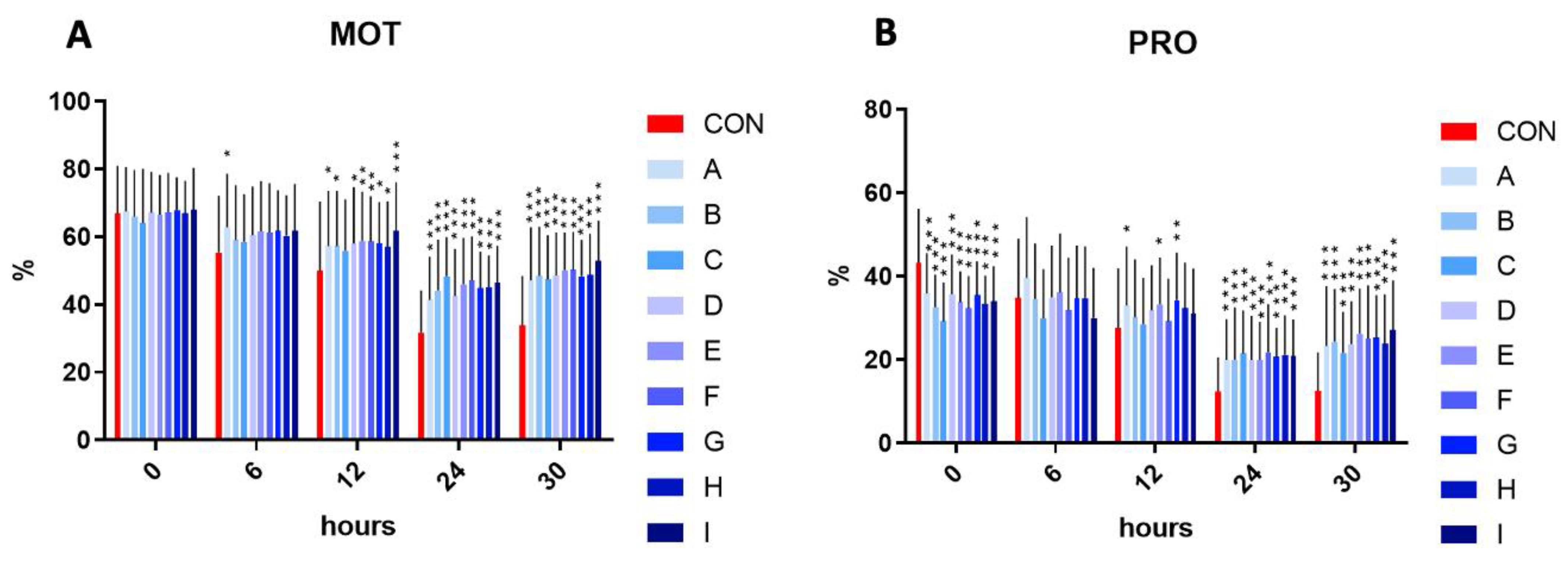
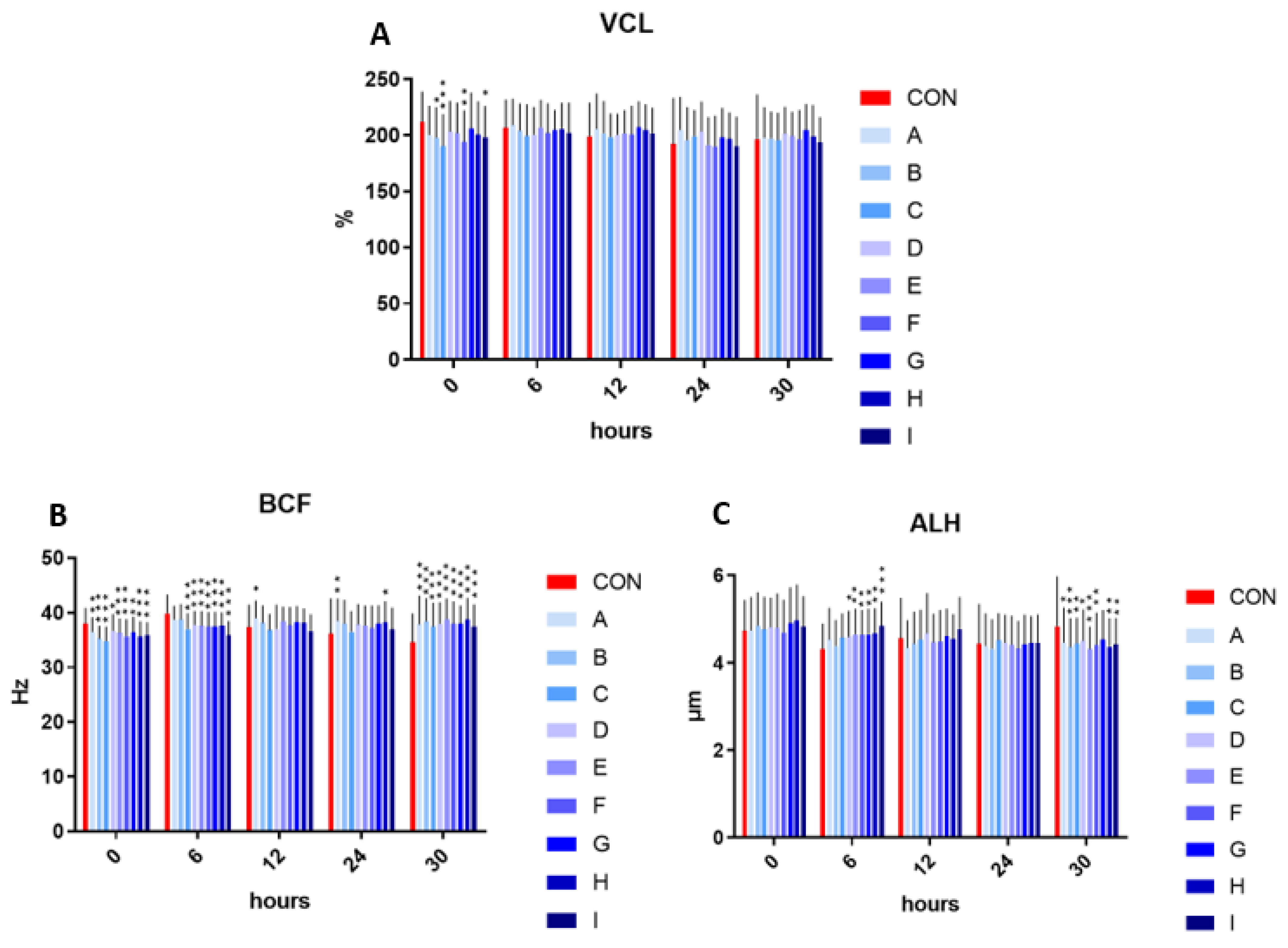
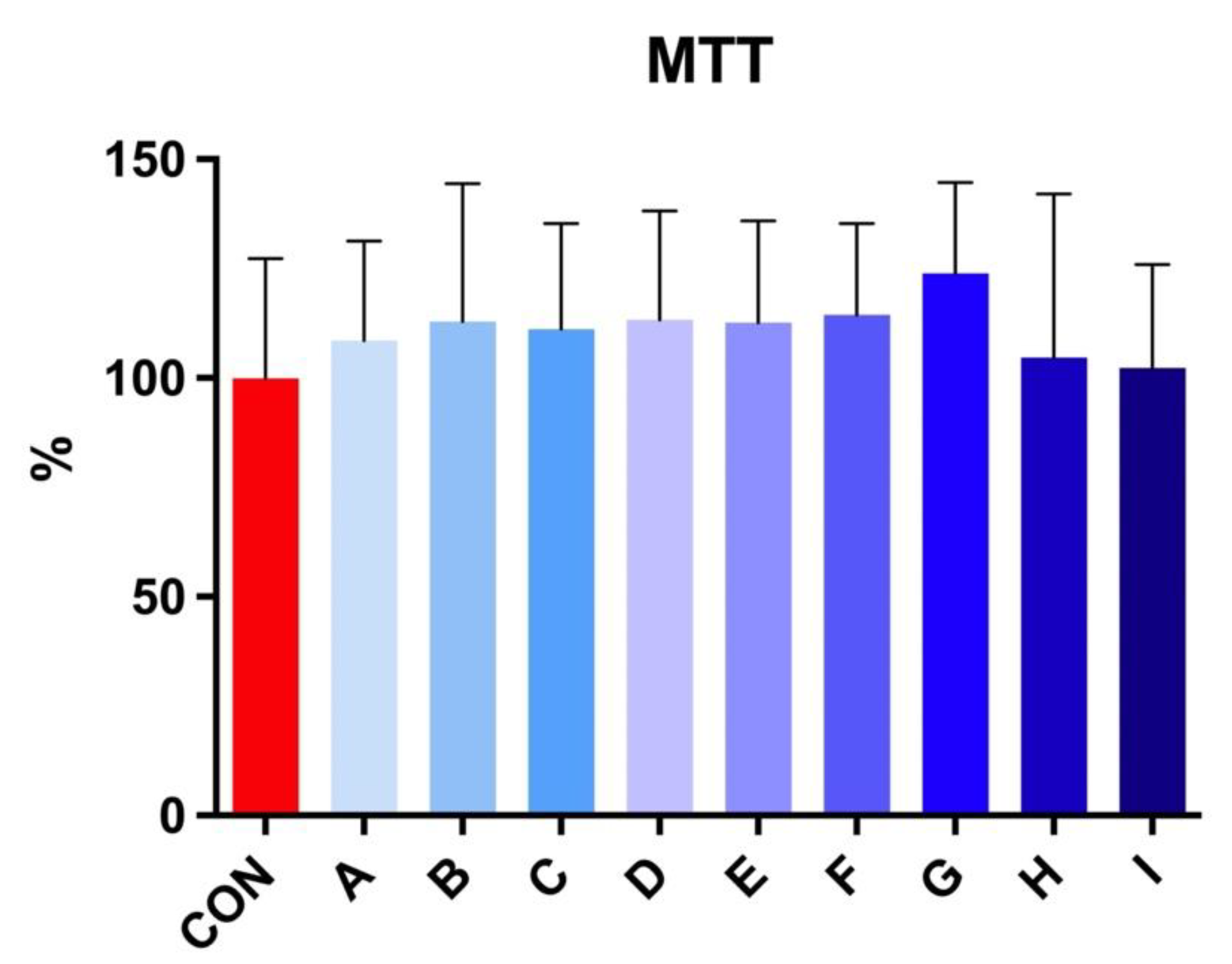
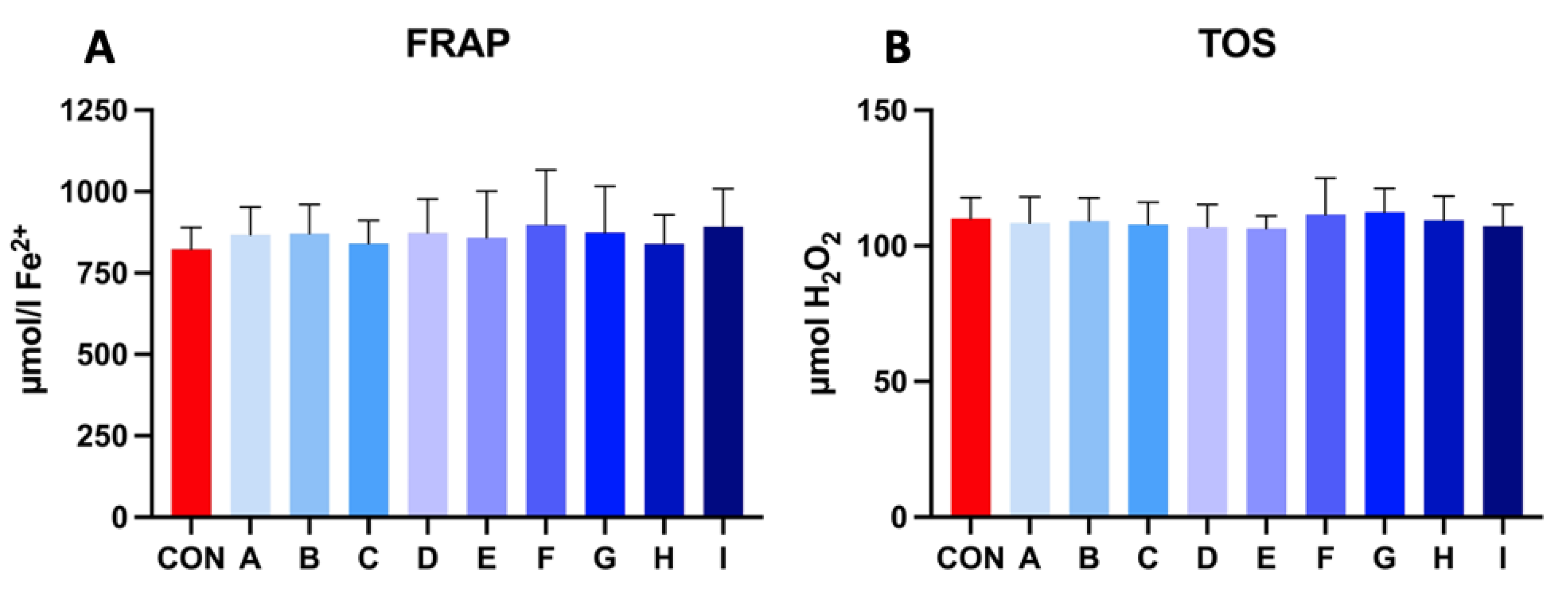
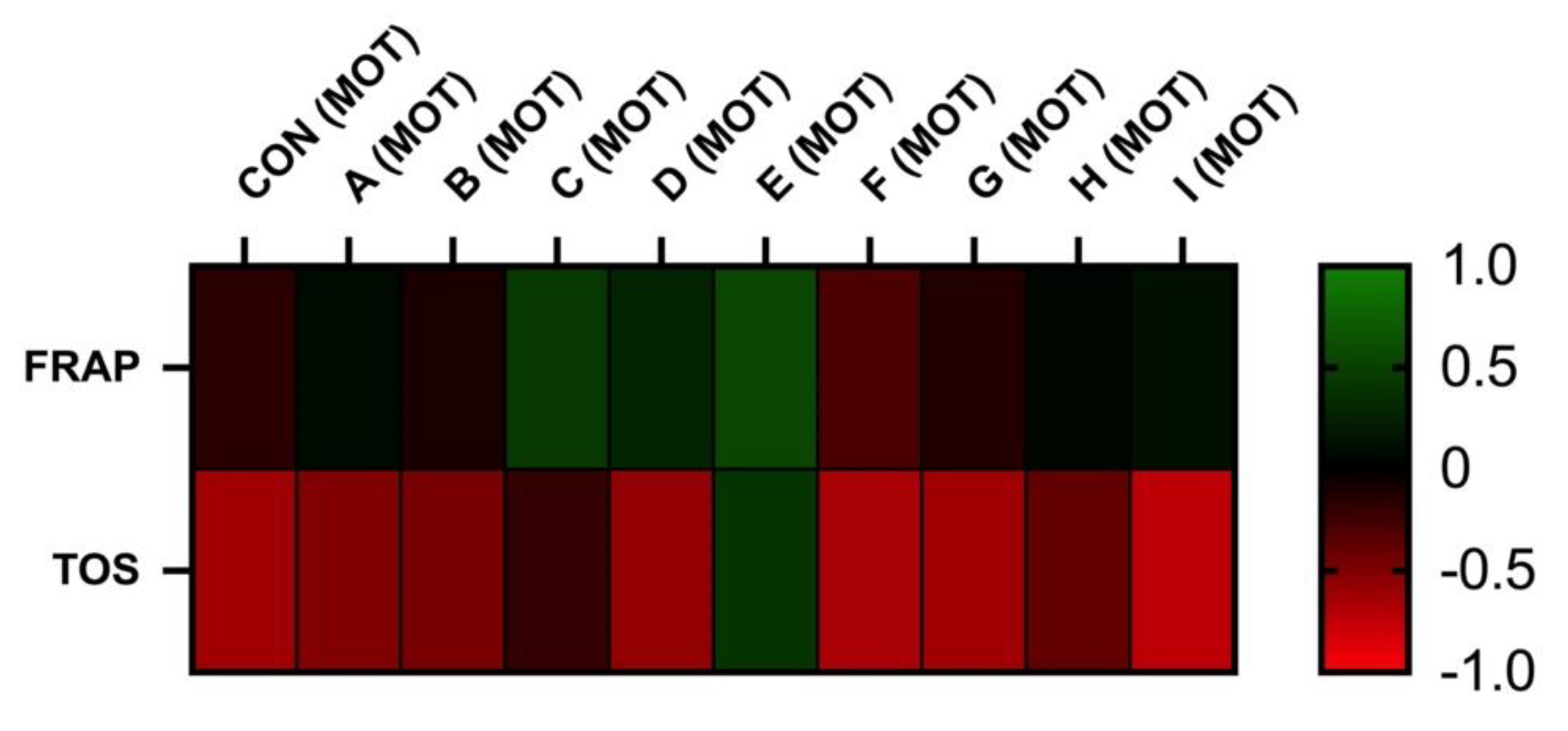
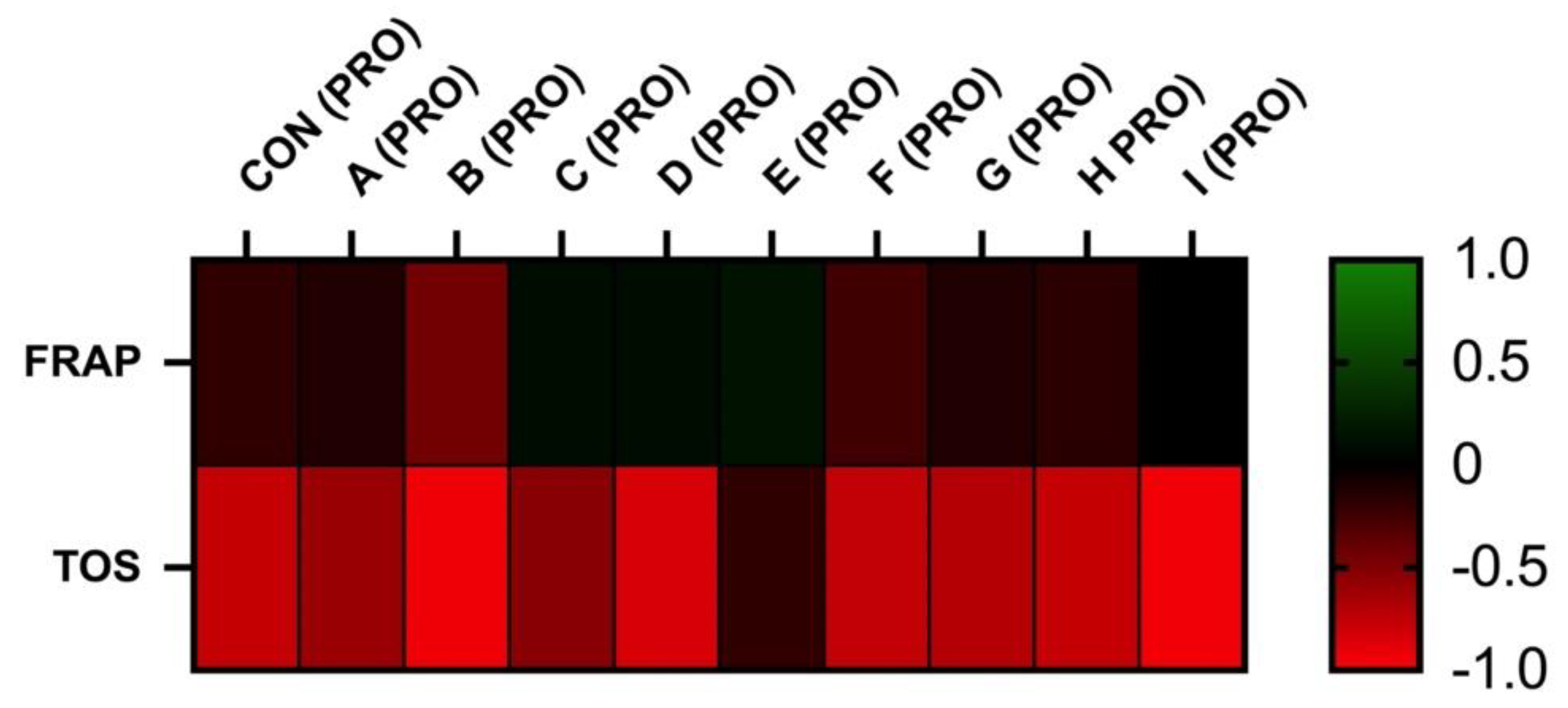
| Group. | Conventional Extender (mL) | Taurine (mg) | Caffeine (mg) |
|---|---|---|---|
| CON | 1 | 0 | 0 |
| A | 1 | 2.5 | 0.625 |
| B | 1 | 2.5 | 1.25 |
| C | 1 | 2.5 | 2.5 |
| D | 1 | 5 | 0.625 |
| E | 1 | 5 | 1.25 |
| F | 1 | 5 | 2.5 |
| G | 1 | 7.5 | 0.625 |
| H | 1 | 7.5 | 1.25 |
| I | 1 | 7.5 | 2.5 |
Disclaimer/Publisher’s Note: The statements, opinions and data contained in all publications are solely those of the individual author(s) and contributor(s) and not of MDPI and/or the editor(s). MDPI and/or the editor(s) disclaim responsibility for any injury to people or property resulting from any ideas, methods, instructions or products referred to in the content. |
© 2023 by the authors. Licensee MDPI, Basel, Switzerland. This article is an open access article distributed under the terms and conditions of the Creative Commons Attribution (CC BY) license (https://creativecommons.org/licenses/by/4.0/).
Share and Cite
Halo, M., Jr.; Tirpák, F.; Slanina, T.; Tokárová, K.; Massányi, M.; Dianová, L.; Mlyneková, E.; Greń, A.; Halo, M.; Massányi, P. A Combination of Taurine and Caffeine in Stallion Semen Extender Positively Affects the Spermatozoa Parameters. Cells 2023, 12, 320. https://doi.org/10.3390/cells12020320
Halo M Jr., Tirpák F, Slanina T, Tokárová K, Massányi M, Dianová L, Mlyneková E, Greń A, Halo M, Massányi P. A Combination of Taurine and Caffeine in Stallion Semen Extender Positively Affects the Spermatozoa Parameters. Cells. 2023; 12(2):320. https://doi.org/10.3390/cells12020320
Chicago/Turabian StyleHalo, Marko, Jr., Filip Tirpák, Tomáš Slanina, Katarína Tokárová, Martin Massányi, Lucia Dianová, Eva Mlyneková, Agnieszka Greń, Marko Halo, and Peter Massányi. 2023. "A Combination of Taurine and Caffeine in Stallion Semen Extender Positively Affects the Spermatozoa Parameters" Cells 12, no. 2: 320. https://doi.org/10.3390/cells12020320
APA StyleHalo, M., Jr., Tirpák, F., Slanina, T., Tokárová, K., Massányi, M., Dianová, L., Mlyneková, E., Greń, A., Halo, M., & Massányi, P. (2023). A Combination of Taurine and Caffeine in Stallion Semen Extender Positively Affects the Spermatozoa Parameters. Cells, 12(2), 320. https://doi.org/10.3390/cells12020320








